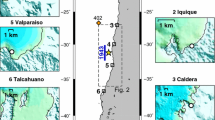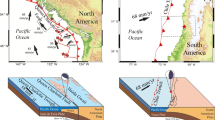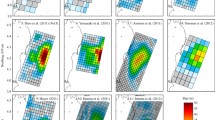Abstract
A major interplate earthquake occurred on September 16th, 2015, near Illapel, central Chile. This event generated a tsunami of moderate height, however, one which caused significant near field damage. In this study, we model the tsunami produced by some rapid and preliminary fault models with the potential to be calculated within tens of minutes of the event origin time. We simulate tsunami signals from two different heterogeneous slip models, a homogeneous source based on parameters from the global CMT Project, and furthermore we used plate coupling data from GPS observations to construct a heterogeneous fault based on a priori knowledge of the subduction zone. We compare the simulated signals with the observed tsunami at tide gauges located along the Chilean coast and at offshore DART buoys. For this event, concerning rapid response, the homogeneous source and coupling model represent the tsunami at least as well as the heterogeneous sources. We suggest that the initial heterogeneous fault models could be better constrained with continuous GPS measurements in the rupture area, and additionally DART records directly in front of the rupture area, to improve the tsunami simulation based on quickly calculated models for near coastal areas. Additionally, in terms of tsunami modeling, the source estimated from prior plate coupling information in this case is representative of the event that later occurs; placing further importance on the need to monitor subduction zones with GPS.
Access this chapter
Tax calculation will be finalised at checkout
Purchases are for personal use only
Preview
Unable to display preview. Download preview PDF.
Similar content being viewed by others
References
Amante, C. and B. W. Eakins (2009), ETOPO1 1 Arc-Minute Global Relief Model: Procedures, Data Sources and Analysis. NOAA Technical Memorandum NESDIS NGDC-24. National Geophysical Data Center, NOAA. doi:10.7289/V5C8276M.
Angermann, D. and J. Klotz (1999), Space-geodetic estimation of the Nazca-South America Euler vector, Earth planet. Sci. Lett., 171, 329 334.
Anderson, J. (2004), Quantitative measure of the goodness-of-fit of synthetic seismograms, 13WCEE conference, paper No 243.
Aránguiz, R., G. González, J. González, P. A. Catalán, R.Cienfuegos, Y. Yagi, R. Okuwaki, L. Urra, K. Contreras, I. Rio and C. Rojas (2016), The 16 September 2015 Chile Tsunami from the Post-Tsunami Survey and Numerical Modeling Perspectives, Pure and Appl. Geophys., 173(2), 333–348, doi:10.1007/s00024-015-1225-4.
Beck, S., S. Barrientos, E. Kausel and M. Reyes (1998), Source characteristics of historic earthquakes along the central Chile subduction zone, J. South Am. Earth Sci., 11:2, 115-129.
Becker, J. J., D. T. Sandwell, W. H. F. Smith, J. Braud, B. Binder, J. Depner, D. Fabre, J. Factor, S. Ingalls, S.-H. Kim, R. Ladner, K. Marks, S. Nelson, A. Pharaoh, R. Trimmer, J. Von Rosenberg, G. Wallace and P. Weatherall (2009), Global Bathymetry and Elevation Data at 30 Arc Seconds Resolution: SRTM30 PLUS, Marine Geodesy, 32:4, 355-371.
Bellotti, G., R. Briganti and G. M. Beltrami (2012), The combined role of bay and shelf modes in tsunami amplification along the coast, J. Geophys. Res., 117, C08027, doi:10.1029/2012JC008061.
Benavente, R. and P. R. Cummins (2013), Simple and reliable finite fault solutions for large earthquakes using the W-phase: The Maule (Mw= 8.8) and Tohoku (Mw= 9.0) earthquakes, Geophys. Res. Lett., 40(14), 3591-3595.
Benavente, R., P. R. Cummins and J. Dettmer (2016), Rapid automated W-phase slip inversion for the Illapel great earthquake (2015, Mw = 8.3), Geophys. Res. Lett., 43, doi:10.1002/2015GL067418.
Blaser, L., F. Krüger, M. Ohrnberger and F. Scherbaum (2010), Scaling relations of earthquake source parameter estimates with special focus on subduction environment, Bull. Seismol. Soc. Am., 100, 2914-2926.
Calisto, I., M. Ortega and M. Miller (2015), Observed and modeled tsunami signals compared by using different rupture models of the April 1, 2014, Iquique earthquake, Nat. Hazards, 79, 397-408, doi:10.1007/s11069-015-1848-x.
Compte, D. and M. Pardo (1991), Reappraisal of great historical earthquakes in the northern Chile and southern Peru seismic gaps, Nat. Hazards, 4(1), 23-44, doi:10.1007/BF00126557.
Demets, C., R. G. Gordon, D. F. Argus and S. Stein (1994), Effect of recent revisions to the geomagnetic reversal time scale on estimates of current plate motions, Geophys. Res. Lett., 21, 2191-2194.
Dziewonski, A. M., T.-A. Chou and J. H. Woodhouse (1981), Determination of earthquake source parameters from waveform data for studies of global and regional seismicity, J. Geophys. Res., 86, 2825-2852, doi:10.1029/JB086iB04p02825.
Ekström, G., M. Nettles and A. M. Dziewonski (2012), The global CMT project 2004-2010: Centroid-moment tensors for 13,017 earthquakes, Phys. Earth Planet. Inter., 200-201, 1-9, doi:10.1016/j.pepi.2012.04.002.
Hayes, G. P., L. Rivera and H. Kanamori (2009), Source Inversion of the W-Phase: Real-time Implementation and Extension to Low Magnitudes, Seismol. Res. Lett., 80(5), 817-822, doi:10.1785/gssrl.80.5.817
Hayes, G.P., D. J. Wald and R. L. Johnson (2012), Slab1.0: a three-dimensional model of global subduction zone geometries, J. Geophys. Res., 117, 1-15.
Hicks, S. and A. Rietbrock (2015), Seismic slip on an upper-plate normal fault during a large subduction megathrust rupture, Nature Geoscience, 8, 955-960, doi:10.1038/ngeo2585.
Kamigaichi, O., Tsunami forecasting and warning. Extreme environmental events complexity in forecasting and early warning (ed. Meyers R.A.), Springer, New York (2011), pp. 982-1007, doi:10.1007/978-1-4419-7695-6_52.
Kanamori, H. and D. Anderson (1975), Theoretical basis of some empirical relations in seismology, Bull. Seismol. Soc. Am., 65(5), 1073-1095.
KanamorI, H. (1993), W Phase, Geophys. Res. Lett., 20(16), 1691-1694.
Kanamori, H. and L. Rivera (2008), Source inversion of W phase: speeding up seismic tsunami warning, Geophys. J. Int., 175, 222-238, doi:10.1111/j.1365-246X.2008.03887.x.
Liu, P. L-F., S-B. Woo and Y-S. Cho (1998), Computer Programs for Tsunami Propagation and Inundation, Cornell University.
Lomnitz,C. (1971),Grandes Terremotos y Tsunamis enChileDurante el Periodo 1535-1955, Geofisica panamericana, 1(1), 151-178.
MASAMURA, K., K. FUJIMA, C. GOTO, K. IIDA and T. SHIGEMURA (2000), Theoretical solution of long wave considering the structure of bottom boundary layer and examinations on wave decay due to sea bottom friction, Journal of Hydraulic, Coastal and Environmental Engineering, JSCE, No663/II-53, pp. 69-78.
Metois, M., C. Vigny, A. Scquet, A. Delorme, S. Morvan, I. Ortega and C-M. Valderas-Bermejo (2014), GPS-derived interseismic coupling on the subduction and seismic hazards in the Atacama region, Chile, Geophys. J. Int., 196, 644-655.
Moreno, M., M. Rosenau and O. Oncken (2010), 2010 Maule earthquake slip correlates with pre-seismic locking of Andean subduction zone, Nature, 467, 198-202.
Murotani, S., K. Satake and Y. Fujii (2013), Scaling relations of seismicmoment, rupture area, average slip and asperity size forM 9 subducting-zone earthquakes, Geophys. Res. Lett., 40, 5070-5074.
Okada, Y. (1985), Surface deformation due to shear and tensile faults in a half-space, Bull. Seismol. Soc. Am., 75, 1135-1154.
Papazachos, B. C., E. Scordilis, D. Panagiotopoulos, C. Papazachos and G. Karakaisis (2004), Global relations between seismic fault parameters and moment magnitude of earthquakes, Bull. Geol. Soc. Of Greece, 36, 1482-1489.
Pardo, M., D. Compte and T. Monfret (2012), Seismotectonic and stress distribution in the central Chile subduction zone, J. South Am. Earth Sci., 15(1), 11-22.
Schurr, B., G. Asch, S. Hainzl, J. Bedford, A. Hoechner, M. Palo, R.Wang, M.Moreno, M. Bartsch, Y. Zhang, O. Oncken, F. Tilmann, T. Dahm, P. Victor, S. Barrientos and J-P. Vilotte (2014), Gradual unlocking of plate boundary controlled initiation of the 2014 Iquique earthquake, Nature, 512, 299-302, doi:10.1038/nature13681.
Sparkes, R., F. Tilmann, N. Hovius and J. Hillier (2010), Subducted seafloor relief stops rupture in South American great earthquakes: Implications for rupture behaviour in the 2010 Maule, Chile earthquake, Earth Planet Sci. Lett., 298, 89-94.
Stern, C. (2004), Active Andean volcanism: its geologic and tectonic setting, Rev. Geol. Chile, 31, 161-206.
Strasser, F.O.,M. C.Arango and J. J. BOmmer (2010), Scaling of the source dimensions of interface and intraslab subduction-zone earthquakes with moment magnitude, Seismol. Res. Lett., 81, 941-950.
Tang, L., V. V. Titov, C. Moore and Y. Wei (2016), Real-Time Assessment of the 16 September 2015 Chile Tsunami and Implications for Near-Field Forecast, Pure and Appl. Geophys., 173(2), 369-387, doi:10.1007/s00024-015-1226-3.
Tassara, A., H. J. Gotze, S. Schmidt and R. Hackney (2006), Three-dimensional density model of the Nazca plate and the Andean continental margin, J. Geophys. Res., 111(B9), doi:10.1029/2005JB003976.
TOLKOVA, E. (2010), EOF analysis of a time series with application to tsunami detection, Dyn. Atmos. Oceans, 50/1, 35-54, doi:10.1016/j.dynatmoce.2009.09.001.
Vigny, C., A. Rudloff, J-C. Ruegg, R. Madariaga, J. Campos and M. Alvarez (2009), Upper plate deformation measured by GPS in the Coquimbo Gap, Chile, Phys. Earth planet. Inter., 175(1-2), 86-95.
Wang, X. (2009), User Manual for COMCOT version 1.7 (first draft), Cornell University.
Wessel, P., W. H. F. Smith, R. Scharroo, J. Luis and F. Wobbe (2013), Generic Mapping Tools: Improved Version Released, EOS Trans. AGU, 94(45), 409-410.
Yamazaki, Y. and K. F. Cheung (2011), Shelf resonance and impact of near-field tsunami generated by the 2010 Chile earthquake, Geophys. Res. Lett., 38, L12605, doi:10.1029/2011GL047508.
Ye, L., T. Lay, H. Kanamori and K. D. Koper (2016), Rapidly Estimated Seismic Source Parameters for the 16 September 2015 Illapel, Chile M W 8.3 Earthquake, Pure and Appl. Geophys., 173(2), 321-332, doi:10.1007/s00024-015-1202-y.
Acknowledgments
We would like to thank Roberto Benavente for sending us his W-phase model prior to its publication, Marianne Me´tois for providing her plate locking data and insightful comments, and finally SHOA for the bathymetry data. The DART records are available from NOAA’s National Data Buoy Center at http://www.ndbc.noaa.gov/dart.shtml. Figures in this study are produced using the Generic Mapping Toolkit of Wessel et al. (2013). Finally, we thank the editor and two anonymous reviewers for their insightful comments and suggestions which greatly improved both our understanding of tsunami data and the quality of this manuscript.
Author information
Authors and Affiliations
Corresponding author
Editor information
Editors and Affiliations
Rights and permissions
Copyright information
© 2017 Springer International Publishing AG
About this chapter
Cite this chapter
Calisto, I., Miller, M., Constanzo, I. (2017). Comparison Between Tsunami Signals Generated by Different Source Models and the Observed Data of the Illapel 2015 Earthquake. In: Braitenberg, C., Rabinovich, A. (eds) The Chile-2015 (Illapel) Earthquake and Tsunami. Pageoph Topical Volumes. Birkhäuser, Cham. https://doi.org/10.1007/978-3-319-57822-4_20
Download citation
DOI: https://doi.org/10.1007/978-3-319-57822-4_20
Published:
Publisher Name: Birkhäuser, Cham
Print ISBN: 978-3-319-57821-7
Online ISBN: 978-3-319-57822-4
eBook Packages: Earth and Environmental ScienceEarth and Environmental Science (R0)




